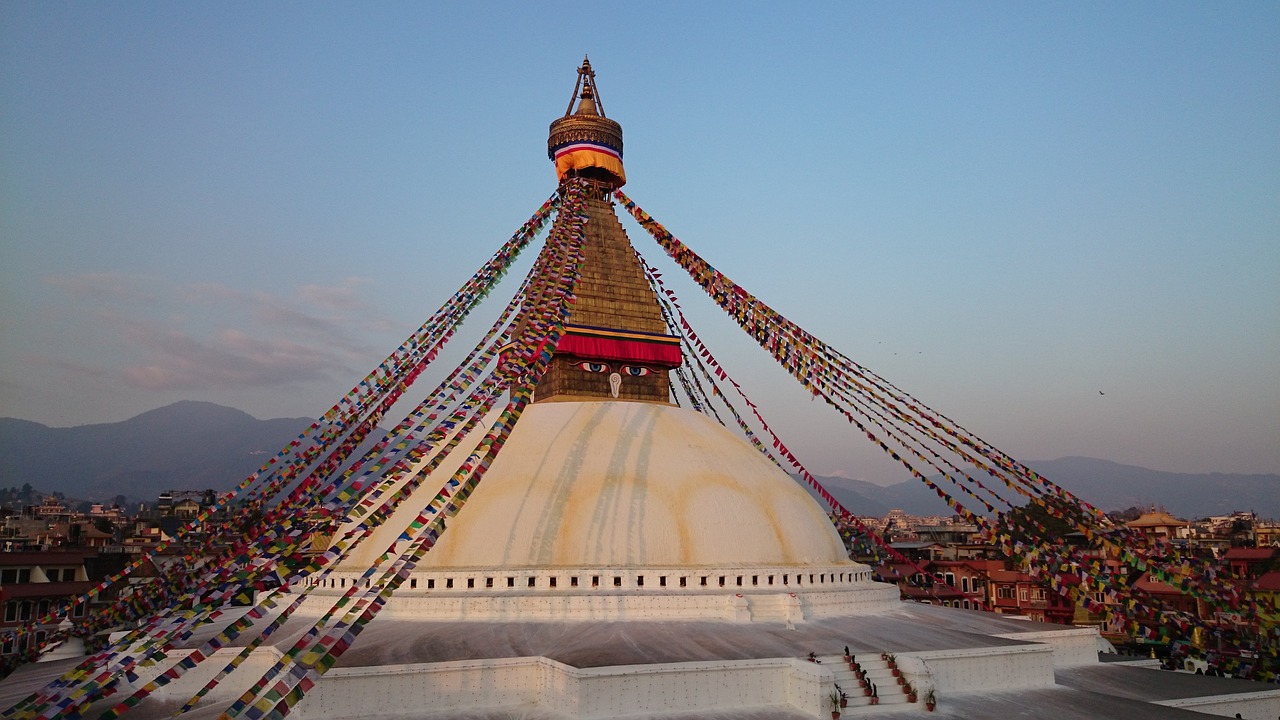In the heart of Kathmandu lies a beacon of tranquility and spirituality—a timeless monument that captivates the soul and stirs the imagination. Boudhanath Stupa, with its mesmerizing presence and sacred ambiance, stands as a symbol of Nepal’s rich cultural heritage and profound spiritual legacy. Join us on a journey to uncover the mystique of Boudhanath Stupa—a place where pilgrims and travelers alike find solace, enlightenment, and a deeper connection to the divine.
A Sacred Sanctuary
As you approach Boudhanath Stupa, you’re greeted by an awe-inspiring sight—a massive hemispherical dome adorned with countless prayer flags fluttering in the breeze. The stupa’s whitewashed exterior gleams in the sunlight, while the gilded spire that crowns its summit reaches skyward, a testament to the aspirations of those who seek enlightenment.
At the base of the stupa, devotees and pilgrims from around the world gather to pay homage to the Buddha and circumambulate the sacred structure in a clockwise direction—a ritual known as kora. As they walk, they spin prayer wheels and chant mantras, their voices blending with the melodious sounds of Tibetan horns and bells that fill the air.
A Center of Buddhist Devotion
Boudhanath Stupa holds a special place in the hearts of Buddhists worldwide, serving as a focal point for meditation, prayer, and spiritual practice. Legend has it that the stupa enshrines the remains of Kassapa Buddha, a predecessor of Gautama Buddha, making it one of the holiest Buddhist sites in Nepal.
For devout Buddhists, a visit to Boudhanath is a pilgrimage—a journey of self-discovery and enlightenment. They come to offer prayers and offerings, to seek blessings from the Buddha, and to bask in the aura of tranquility that permeates the sacred space. The stupa’s all-seeing eyes gaze out from the four cardinal directions, a reminder of the Buddha’s eternal wisdom and compassion.
Architectural Splendor
Boudhanath Stupa is not only a spiritual sanctuary but also a masterpiece of Newari architecture—a testament to the skill and craftsmanship of Nepal’s artisans. The stupa’s whitewashed dome is adorned with intricate carvings and colorful prayer flags, while the gilded spire that tops its summit shimmers in the sunlight.
Surrounding the stupa are a series of smaller stupas, temples, and monasteries, each adding to the stupa’s grandeur and spiritual significance. The monastic complex that surrounds Boudhanath is home to a vibrant community of monks and nuns who devote their lives to the practice of Buddhism and the pursuit of enlightenment.
Cultural Fusion
Boudhanath Stupa is not only a center of Buddhist devotion but also a melting pot of cultures and traditions. The stupa’s unique architecture reflects a blend of Tibetan, Nepali, and Indian influences, while its vibrant atmosphere attracts visitors from all walks of life.
As you wander through the bustling streets that surround the stupa, you’ll encounter a kaleidoscope of sights, sounds, and smells—a vibrant tapestry of life that reflects the diversity and richness of Nepal’s cultural heritage. Market stalls overflow with colorful handicrafts, prayer beads, and religious artifacts, while the aroma of incense fills the air, mingling with the scent of exotic spices and fragrant flowers.
Practical Tips for Visiting Boudhanath Stupa
Before you embark on your journey to Boudhanath Stupa, here are some practical tips to enhance your experience:
- Respectful Attire: As Boudhanath is a sacred site, it’s important to dress modestly out of respect for the local customs and traditions. Avoid wearing revealing clothing, and remember to remove your shoes before entering the stupa or any other sacred spaces.
- Quiet Reflection: Boudhanath Stupa is a place of meditation and reflection, so be mindful of your behavior while visiting. Keep noise to a minimum and refrain from loud or disruptive behavior that may disturb other visitors or worshippers.
- Circumambulation: Join the pilgrims as they walk clockwise around the stupa, spinning prayer wheels and chanting mantras. This ritual, known as kora, is believed to accumulate merit and purify negative karma.
- Visit at Sunset: For a truly magical experience, visit Boudhanath Stupa at sunset, when the golden rays of the sun cast a warm glow over the sacred structure. The atmosphere is especially tranquil during this time, making it the perfect opportunity for quiet contemplation and introspection.
Conclusion: A Journey of Enlightenment
As you bid farewell to Boudhanath Stupa and the sacred sanctuary it embodies, you carry with you a sense of peace, enlightenment, and spiritual renewal. Whether you’re a devout Buddhist seeking blessings or a curious traveler in search of inspiration, Boudhanath offers a journey of discovery unlike any other—a journey that transcends time and space to touch the very essence of the human soul.
So come, immerse yourself in the mystique of Boudhanath Stupa, and let its timeless wisdom and profound spirituality guide you on the path to enlightenment. For in the shadow of the all-seeing eyes of the Buddha, all are welcome, and all are one.


